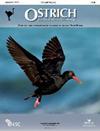角鸬鹚是否会在竞争中失利?与商业渔业的饮食重叠
IF 1.1
4区 生物学
Q2 ORNITHOLOGY
引用次数: 0
摘要
Cape Cormorants Phalacrocorax capensis在南部非洲本格拉上升流系统繁殖,2013年被国际自然保护联盟列为濒危物种,最近三代的数量减少了50%以上。这一减少与猎物供应减少有关,特别是远洋浅水鱼类昂氏凤尾鱼和沙丁鱼。1988年至2007年,从南非西部11个地区采集的929份反刍猎物样本中,对开普Cormorants的饮食进行了检查。从数量上看,凤尾鱼是所有年份中最重要的猎物,但2007年除外,2007年样本的地理分布有限。总的来说,凤尾鱼占所有猎物的85%,沙丁鱼占6%。然而,从1988年到1997年,西南部93%的食物都是沙丁鱼。1988–1997年至1998–2007年间,凤尾鱼对饮食的比例贡献增加,而沙丁鱼的比例则下降。西北部吃的鳀鱼比中西部和西南部吃的要小。所有地区都吃小而未成熟的沙丁鱼,但成熟的沙丁鱼只在西南部,那里是西部沙丁鱼种群的产卵地。鳀鱼和沙丁鱼是南非围网渔业的目标。大多数被角海鳗吃掉的凤尾鱼和沙丁鱼的尾部长度分别为5-9厘米和15-21厘米,与渔业捕捞的尺寸有相当大的重叠。这突出了角海鳗与渔业对凤尾鱼和沙丁鱼的竞争潜力。本文章由计算机程序翻译,如有差异,请以英文原文为准。
Are Cape Cormorants Phalacrocorax capensis losing the competition? Dietary overlap with commercial fisheries
Cape Cormorants Phalacrocorax capensis breed in southern Africa’s Benguela upwelling system and in 2013 were listed as Endangered by the IUCN following a population decrease of >50% over their three most recent generations. This decrease was associated with reduced prey availability, particularly of the pelagic shoaling fishes Cape anchovy Engraulis encrasicolus and sardine Sardinops sagax. The diet of Cape Cormorants was examined from 929 regurgitated prey samples collected at 11 localities off west South Africa from 1988 to 2007. By number, anchovy was the most important prey in all years, except 2007, in which the geographical distribution of samples was limited. Overall anchovy contributed 85% of all prey items eaten and sardine 6%. However, from 1988 to 1997, sardine formed 93% of the diet by mass in the southwest. The proportional contribution of anchovy to the diet increased between 1988–1997 and 1998–2007, whereas that of sardine decreased. Anchovy eaten in the northwest were smaller than those caught in the central west and southwest were. Small, immature sardine were eaten in all regions, but mature sardine only in the southwest, the spawning ground of the western sardine stock. Anchovy and sardine are targeted by South Africa’s purse-seine fishery. Most anchovy and sardine eaten by Cape Cormorants had caudal lengths of 5–9 cm and 15–21 cm, respectively, and showed considerable overlap with sizes harvested by the fishery. This highlights the potential for competition between Cape Cormorants and the fishery for anchovy and sardine.
求助全文
通过发布文献求助,成功后即可免费获取论文全文。
去求助
来源期刊

Ostrich
生物-鸟类学
CiteScore
2.10
自引率
30.00%
发文量
24
审稿时长
>12 weeks
期刊介绍:
Ostrich: Journal of African Ornithology is the leading ornithological journal in Africa, and publishes peer-reviewed scientific papers and short communications (
 求助内容:
求助内容: 应助结果提醒方式:
应助结果提醒方式:


